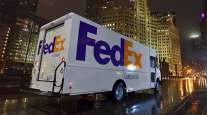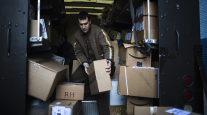Online Surge Raises Questions About Delivery Network
A 20% surge in online holiday shopping — much of it just days before Christmas — brought the retailing and shipping industries closer to a tipping point many experts think is inevitable.
The steady rise in online shopping creates an annual tsunami of deliveries that stretches the system well beyond the normal demand, forcing patchwork solutions.
UPS added 24 “pop-up” sorting locations around the country and temporarily expanded its capacity to move packages by paying for the use of extra trucks and planes for the holiday season. It also bolstered its normally all-brown fleet by renting U-Hauls or other vehicles.
Archrival FedEx, which took similar steps, struggled with delayed shipments from an unexpected increase in last-minute online orders. It was still delivering some on Christmas Day and the day after.
UPS and FedEx rank Nos. 1 and 2 on the Transport Topics list of the Top 100 largest for-hire carriers in the United States and Canada.
“People are last-minute shoppers now,” said David Huckeba, managing director at Intelligent Audit. “Somebody’s going to order some Beats headphones at 2 a.m. on Sunday ... that they could have ordered all year long.”
Preliminary results suggest online ordering saved the season for retailing, and that the vast majority of orders made it where they were going on time. MasterCard’s SpendingPulse report said overall holiday spending rose 7.9%, with online sales driving much of the gain. Online titan Amazon reported record sales.
UPS had early troubles after the “Cyber Monday” ordering rush, but spokesman Glenn Zaccara said the company had about 97% to 98% on-time delivery through Christmas Eve.
The inexorable shift toward online shopping is creating tension, however.
Brick-and-mortar stores, pushed by Amazon, are making promises they can’t keep without shipping companies building out bigger logistical delivery infrastructure. And shippers are wary of making costly moves to enlarge their systems just to satisfy last-minute shoppers.
“You simply cannot add 50 airplanes or 2,000 tractor-trailers and drivers that you need for two days a year and be financially prudent,” Huckeba said. “You can’t do that in any business.”
Amazon has been exploring ways to build its own logistics network to make itself less dependent on UPS. Amazon made headlines saying it might explore leasing its own fleet of cargo jets.
UPS downplays any friction.
“Amazon is a good customer of ours and we work closely with them,” UPS CEO David Abney told CNBC.
“We feel that as long as we continue to invest in our business, add the value that we do with our global scale... that really we just don’t see how any of our large retailers would be better off without us. So we feel very comfortable in that relationship.”
In any case, the shift shows no sign of plateauing. Amazon said almost 70% of its customers shopped using a mobile device during the season, suggesting consumers are no longer limited to buying while sitting in front of a desktop at work or from laptops during downtime at home.
They are buying on-the-go — a boon for business as long as the demand can be met.
“This has been going on for a while, but it really accelerated in the past couple of quarters,” said Chris Christopher, IHS Global Insight director of consumer economics. “It’s been a game changer.”
Experts point out that in-store shopping still accounts for most retail dollars spent, but the share is dropping. For instance, spending at physical stores during this year’s Black Friday week was down 5% compared to last year, but increased 5% online, said Dani Cushion, chief marketing officer for Atlanta data analysis firm Cardlytics.
Retailers spread out “doorbuster” sales to last longer than a few hours or a weekend, so this year’s consumers were able to shop later in the season, putting more pressure on quick delivery.
“Retailers have made it easier to ship later,” Cushion said. “They are listening to what consumers want and they are pushing, pushing, pushing” delivery times.
UPS said it worked more closely with retailers to get orders the weekend before Christmas and on the way on Monday, Dec. 21. That made Monday the busiest shipping day for UPS – a day earlier than planned — and provided a cushion.
The extra day “really helped UPS smooth out the rest of the Christmas week,” spokesman Zaccara said.
UPS also increased its permanent processing capacity by nearly 6% in advance of the holidays by expanding facilities.
Kurt Salmon’s Osburn said for UPS to expand its network by 20% to handle future growth in e-commerce would likely require billions of dollars of investment.
“For them to try to keep up with that kind of growth is impossible,” he said. “So retailers are going to have to figure out a way to get the product to the customer at different times, or through different channels.”
Retailers may be interested in “taking back the wheel on this one,” said Jonathan Colehower, chief marketing officer for Atlanta-based logistics software company Manhattan Associates, which makes systems for retailers to manage orders and logistics. Retailers will be interested in figuring out a way to “shape demand versus always having to respond to it,” by charging more for orders during peak times, for example, Colehower said.
In the past, the holidays just meant more boxes delivered to the same stores, with minimal increase in stops and delivery costs, noted Satish Jindel, president of tracking software developer ShipMatrix.
But with online orders, that model is turned upside down, with warehouses becoming individual order packing centers and products pieced out into thousands of separate deliveries to residents.
Deliveries now go out in hundreds of smaller trucks fanning out to neighborhoods where they deliver products to individual doorsteps — a more costly, time-consuming and less efficient process, though one that has enabled a revolution in shopping for consumers.
Among the alternatives to doorstep deliveries is in-store pickup, which cuts shipping costs while allowing immediate gratification.
But for the most part that is limited to big box retailers, and it requires them to turn stores into order fulfillment centers while also trying to handle the holiday rush of shoppers.
In Kurt Salmon’s audit of online orders, only about 40% of in-store pickup orders were actually ready for pickup when the shopper went to the store.
“For a lot of retailers, this was the first peak season they tried to do it,” Osburn said. “Performance of buy online-pick up in store was terrible for a lot of retailers.”
When the dust settled, UPS hit 97.7% for on-time delivery performance, compared to 96.2% at FedEx, according to ShipMatrix, a shipping software company that tracks the industry.
FedEx, UPS and the U.S. Postal Service delivered more than 60 million packages on Christmas Eve — 70% more than an average day, ShipMatrix said.
But the massive numbers involved, coupled with complaining via social media, increasingly amplifies delays. Even if on-time performance were 99%, 600,000 packages would be delivered late, the firm said.
The growth in online shopping also means more returns. Items are more likely to be returned because they are not seen in person or tried on. Some people order items of different types or sizes, then return those they don’t want.
“We’re seeing such an increase in returns,” said Jim Brill, UPS marketing manager for returns. “It’s really driven by e-commerce.”




